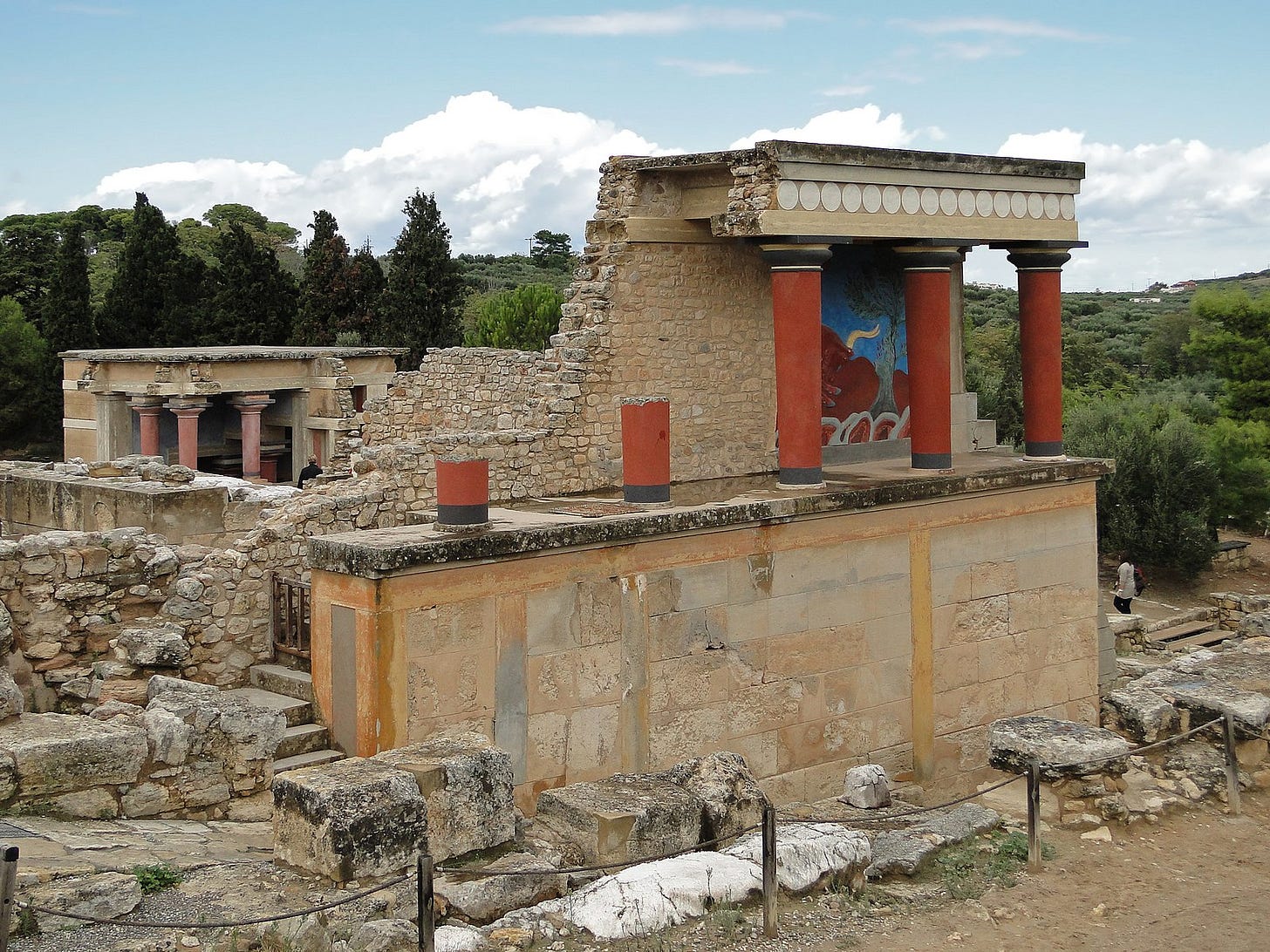Image: Knossos, on the island of Crete: the north portico. Of course, “reconstructed”. By Bernard Gagnon.
Kurt, my housemate, sniggers. “It’s a pile of stones.” “Kurt,” I reply, “A quarry is a pile of stones. This is a monument of ancient history and a monument to man’s development.” Kurt sniggers again, “It’s a pile of stones.”
The difference between those imbued in the significance of history and with the imaginative acumen to transport themselves back in time at the sight of a sliver of pottery, a shard of glass or a stump of a column and those who view such things as slivers of pottery, shards of glass and stumps of columns is that, in the end, some see them as a passport into reliving the ancient past and some see them as an insignificant remnant in today’s world that might well have borne significance in the past but now is rendered insignificant. On one view, Kurt’s, a pile of stones is just that, regardless of what it might have been in the bronze age. And that’s his view of the Palace of Knossos.
Visitors to Knossos can marvel at this pile of stones, some of which have been “reconstructed” into what they formerly represented, for others of which tableaux show what the pile of stones once looked like, with folders and booklets to explain the glories of this once magnificent site. With imagination, one can recreate this glory in one’s mind’s eye. Without it, one sees – a pile of stones.
When I worked in tourism with high school students from the US, I had lectures which I would relate to them in the coach as we entered certain significant parts of Europe and I had one for Italy that was filled with admonitions.
“During your stay, you will pass by statues and monuments being used here as doorstops, or standing forlorn in corners of courtyards, which, in your home towns, would be under glass cases protected by alarm systems and vaunted to the heights as the ultimate in Roman sculpture. Italy is brimming with ancientness, to the point where its citizens take it all very much for granted and have not the space to display every last vestige of their illustrious past; to the point where every new road or sewer system gets held up for months and years as archaeologists delve into the ochre earth to examine some new discovery about this nation’s past, while the sewage backs up in outmoded pipe systems; it’s a point at which the casual visitor, such as yourselves, can very easily OD on culture. You will return foot-weary to your hotel rooms and flop onto your beds and mutter the mnemonic that is the bane of the Grand Tour tourist: ABC. Another Bloody Cathedral. Another Bloody Castle. Another Bloody Church. Another Bloody Cultural Heritage Site. Upon returning home, it will all seem like a blur. So, focus. Don’t blur. You’re here for a few days. You can OD for a few days. It’s the fix you came for.”
Some who returned home from their high school trips will undoubtedly have related that they saw an awful lot of piles of stones. And, on some of that stony ground, perhaps seeds of cultural interest did flourish into curiosity. Of all the horses led to water, only some will drink. And some may drown. But culture in the likes of Italy and Greece is hard to dole out in measured doses.
Athens, I read, displays less than 10% of the artefacts it holds in warehouses and is building a new museum to be able to display a far greater range of the ancient wonders it holds. In five years or so, when the new museum is complete, perhaps you will visit it. Perhaps you will be inspired by its wonders. Perhaps you will even OD; and perhaps you will drown.
One of the best ancient museums I ever visited was the John Paul Getty Villa in Los Angeles. Whatever view one might have of Mr Getty and the means by which he acquired his invaluable collection for the American nation, which he traded with its government in return for tax breaks, one cannot but be of the notion that the Villa is a magnificent collection of some of the world’s finest artefacts, beautifully displayed and, bar the car parking fee, free for all to wonder at. Each piece is a “choice selection.” None serves as a doorstop, and the visitor is at no point challenged to assess whether what they see is a work of art worthy of their attention or some old bit of stone that would, in Italy, have been swallowed up in a sewer excavation.
Some would baulk at the idea of another choosing for them what is to be admired and what disregarded. Some are glad to have the best vaunted for them, and brought effortlessly to their attention. But which of these each of us is, at the end of a day of appreciation, we all flop onto the bed in our hotel rooms and mutter, “ABC,” whether we mean “another bloody cultural site,” or “another beautiful collection.”





My most recent visit to a library was in New York. A scorching day, I took refuge in it with a book. I sat at a long table with a number of other drop-ins. Everyone was quiet and reading. After a few pages I caught myself inspecting the people around me. A motley bunch: students, tourists, people on a lunch break, tired-looking people, an elderly guy with a worn book, a young kid. It was fascinating to sit and share time with strangers turning the pages of our books. Cycling to work this morning , I saw a poster advertising FB’s metaverse. I want mine in a library.
Was. It appears the library is now closed, since 30 November. Sad.